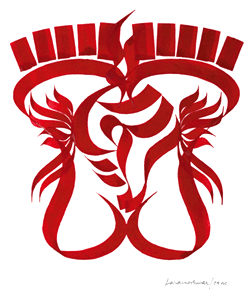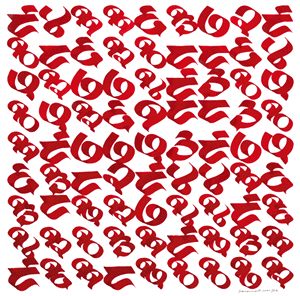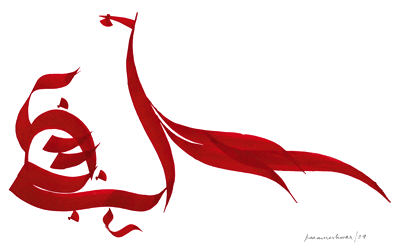- Guest Editor’s Column
- Docedge the Asian documentary forum
- Creative Impulse
- Arts and Crafts Movement : Mission Style Furniture
- Porcelain-enamel Advertising Signs
- Passions run high over the auction of Tagore's paintings
- In the News
- Controversy
- Artist Index and Statistics
- Market Insight
- Auction Reports : What happened
- Auction Reports : what's forthcoming
- Art's eye-view
- The month that was
- Mumbai Artsighting
- Art Bengaluru
- Musings from Chennai
- Deccan Odyssey
- North-East Opsis
- The Wreckage
- Inscription in Bronze
- Black and White
- Nature God
- Indian Highway
- Structures Within an Intervention
- Hard Talk
- Different hues of Aakriti
- Christie’s : Important Watches
ART news & views
Deccan Odyssey
Volume: 2 Issue No: 5 Month: 6 Year: 2010
a
Writing rhythm, mythology and celebrations works of Poosapati Parameshwar Raju
• Previewed at Shrishti Art Gallery, Hyderabad, 2009
a
• Showcased only a section at the Apparao Galleries as Linear Rhythms,
Chennai, 2010
a
• The works would also travel to Bengaluru, Mumbai and Kolkata till 2011
Reinforcing the tradition of writing with the nib is what essentially inspired Poosapati Parameshwar Raju to explore the beauty of calligraphy. From an intention to write well, his objective gradually shifted to nurturing the pictorial possibilities of interpreting scripts of describing them with meaning and imparting information. Hailing from Vizianagaram, the 48 year-old Parameshwar [born in 1961] is conversant with ancestral history, traditional customs, rituals and folklore that have been handed down through generations.
 |
Over the years, Parameshwar has accrued a surfeit of imagery of signs and symbols related to iconography, rituals and customs that have emerged from his unique technique. Practice of twenty five years has strengthened his skill to present poignant signification in his images. The basic drawing that develops from a thin line, continuing as a thick line and concluding as a thin line, attributes a rhythmic quality to the image. The progression of the line in this particular sequence and variation has a philosophical interpretation that denotes the transformation from its creation, through its development, ending with the passage of time.
The traveling exhibition showcases a selection that has emerged from regularity of practice, and compiled from the works of eight different series. From the stylised Aums, the series of significant trees titled Benign Perch, the radiant flow depicting the celebration of lights, and the series of Three Chariots to the festive flame sustained by the legends of the Krishna Jagannath in Puri, the stylised formation of butter lamps and its placement in the Southern temples. The exhibits also include the stylised birds and creepers from The Benign Perch-II, the Navagraha, Panchayatanas, Surya, and images nourished by the epic tales of Ramayana and mythologies of the temple of Mylapore, and depictions of Brahma, Vishnu, Shivah and a series of the Ramayana - his most recent works.
Parameshwar has brought into prominence, a plethora of images that is convincing and has the capability to stand alone, strengthened by their various meanings, the construction of the imagery and the information regarding mythology, culture and tradition. Delving into his subjects, he has given references to temple carvings, rituals and practices, as well as old books.
 |
The carvings on temple walls are calligraphic in nature although they are chiselled and not written with a nib. Parameshwar's exploration of the previously realised images ascribes continuity, meaning and knowledge from the past to his work. These image references are culled from existing symbols and elements from traditional iconography the representation of Venkateshwara by the elaboration of the Urdhva Pundra, or the sign of the Vishnu namam to adapt the role of a signifier as an embodiment of Vishnu. This selective stylisation evident in his imagery creates forms or insignias that are characteristically minimal, imbibes narration and is integral to its own meaning. The amalgamation of signs, symbols and insignias culminate into significant forms and cultural reminders.
In the work titled Vishnupada, the distinct roles played by the Shankh as the emblem of Vishnu, the feet as the symbol of arrival, and their juxtaposition creating the signifier the blessing ceremony at the Rangannaswamy temple. In the works titled Raas Leela, Krishna and Arjuna on the Chariot, the three chariots, Tree of belief, The Pillar of Fire, and Sreekara Murti, it is noticeable that as an entirety, the sign, symbol, insignia trio conjure meaningful ceremonial and narrative associations in the visualisation. The imagery confronts the viewer with questions that concern the alienation from one's inheritance, the restoration of cultural knowledge, and its reinterpretation in culture-specific context and dissemination.
In the context of creative expression, the implications of external concerns societal, political, religious are meaningless unless the creator acknowledges or attributes such issues to his works. Parameshwar's expression is natural celebration of his knowledge and perception of culture. His habitual application has strengthened his skill to calligraphically present poignant significance in his images. Adherence to measurement, symmetry and perfection are associated with indigenous art practice in India, broadly categorised as craft after the colonisation of India and continuing to be convincing enough for the Indian mind.
Art making creates an allowance for all attitudes. It accommodates disjunctive juxtapositions, and then the logic of being skill less and incoherent when it is necessary for impregnating the image with the idea is considered as a language sign. The contrary use of skill in being rendered as a language by itself is overlooked in contemporary art and associated with craft. This is largely due to the perceptions of the Occident towards indigenous art practices of the Orient. The discussion is relevant here as temple carvings with all the signs and significations have lost their power of communication by being labelled a decorative craft. Parameshwar has become aware of this fact in the course of his practice and travel within the country.
 |
The notion of decoration in India is a simulation of celebration. Embellishment is not conceived according to the western notion but as a mode of preparation to receive good tidings, enlightenment, vision and union with the cosmos.
Parameshwar's works are a visualisation of an intimate relation and portray a marriage between seeing and thinking, image and idea. The eventual image is stylised, minimal with a balance of both the constructs formal and conceptual. In its emphasis on the interdependence of the visual and intellectual, the uniquely important role of the visual and its influence are reclaimed in Parameshwar's image making as in traditional forms and iconography.
The vast reference from celebrations, mythology and folklore not only sustains the content of his work but also the manner of perceiving an image and giving shape to things we cannot readily see in a set of ideas and beliefs. The form finally emerges as an essence, free in its manifestation and yet not different from the reality of the narrative form that allows the mind to grasp all aspects of its constituent elements.
In works of Parameshwar, the combination and juxtaposition of signifiers and emblematic formations lucidly expresses celebrations within the temple and outside, in the trees, the birds and ambiguities of the narratives.
Koeli Mukherjee Ghose